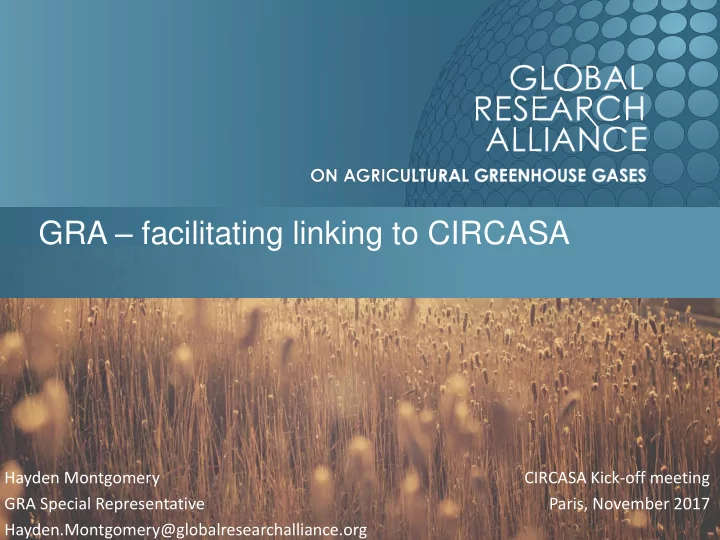

GRA – facilitating linking to CIRCASA Hayden Montgomery CIRCASA Kick-off meeting GRA Special Representative Paris, November 2017 Hayden.Montgomery@globalresearchalliance.org
Sustainable intensification of livestock systems with leguminous crops: Latin America and Caribbean cooperation platform
Victor Asencio Cuello Luis Rodríguez Bruno Alves Félix Picado Zeledón Alodia González Fernando Lattanzi Marta Alfaro Executing institution: Alejandro Costantini Miguel Taboada
RATIONALE OF THE PROJECT • These countries have almost 300 million beef cattle heads, representing almost 20% of world stocks • Most of the land dedicated to pastoral livestock is located in low fertile areas marginal for cash crops and rangeland areas. • Native legumes are scarce in the livestock forage supply, thus affecting the diet quality and the potential for soil C sequestration. • Global livestock markets have new ongoing demands, not only in terms of quality, traceability, health and animal welfare, but also environmental footprint.
Main objectives a) Promote a sustainable intensification of LA&C livestock systems by the use of forage legumes and improving biological nitrogen fixation; b) Increase soil carbon stocks in pastoral systems.
ACTIVITIES Work Packages 1.1. Constitution of the Platform 1.2. Governance Mechanism WP1. Cooperation Platform 1.3. Presential and virtual coordination meetings 1.4. Technical and financial management WP2. Evaluate the impact of 2.1. Biological N fixation forage legumes on soil 2.2. Soil C sequestration properties, animal 2.3. GHG emissions productivity and GHG 2.4. Livestock productivity emissions 3.1. Virtual platform 3.2. Results diffusion and WP3. Education skills and dissemination training 3.3. Training
2.1. Biological N fixation Objective : to carry out a large-scale survey on BNF by forage legumes and their capacity to supply N Methods : natural abundance of 15 N Who will do it? : INIA-Uruguay, EMBRAPA-Brazil, INTA- Argentina, INIA-Uruguay, IPTA-Paraguay, IDEAF-Dominican Republic, INIAP-Ecuador.
2.2. Soil carbon sequestration Hypothesis: The inclusion of legumes in pastures could bring about an increase in the amount of SOC stored in the soil due to the biological fixation of nitrogen. Objective: To quantify SOC in soil in areas of land under various years of management with and without the presence of legumes, selected in same soil types and same historical land use. Who will do it ?: EMBRAPA-Brazil, INTA-Argentina, INTA-Nicaragua, INIA- Chile, INIA-Uruguay, IPTA-Paraguay, IDEAF- Dominican Republic, INIAP- Ecuador.
2.2. Soil carbon sequestration (cont..) Method: Analysis of soil samples to determine SOC and N in soils 50cm – 1m depth. Sampling sites: 16 pairs of treatments from temperate zones already identified (Argentina, Chile, Uruguay and the South of Brazil) 13 pairs in tropical zones to be identified (Brazil, Paraguay, Nicaragua, Dominican Republic and Ecuador).
2.3. GHG emissions Objective: Quantify the effect of forage legumes on N₂O and CH 4 emissions from soil, and on enteric CH₄ emissions by cattle. Methods: Gas sampling with static chambers. Enteric CH 4 with SF 6 and animal consumption Gas chromatography Who will do it?: INIA-Chile, INTA-Argentina, EMBRAPA -Brazil, INIA-Uruguay
2.4. Animal productivity Objective : Quantify the impact of forage legumes on animal productivity (e.g. live weight gain). Methods : analysis of published (including “grey” literature) and unpublished information. Who will do it ?: INTA Argentina, EMBRAPA-Brazil, INIA-Chile, INIAP- Ecuador, IPTA-Paraguay
3.1. Virtual Platform Objective : • Design an open access digital platform (web page). • Design communication materials and perform activities. • Offer technical-scientific training Who will do it ?: INTA - Argentina, EMBRAPA- Brazil, INIA-Chile, INIAP-Ecuador, IPTA- Paraguay, IDIAF Dominican Republic, INIA-Uruguay, INTA- Nicaragua Collaborators : IICA / PROCISUR, FONTAGRO
Thank you ! Contact: costantini.alejandro@inta.gob.ar
Recommend
More recommend